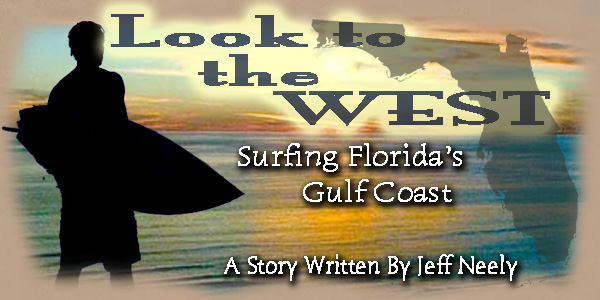
For residents
of Huntington Beach or the North Shore, surf culture is surely as pervasive
as the sea air itself. But for Florida surfers living on the Gulf of
Mexico, a real scene to call their own has been a long time lacking.
Not only has mainstream surf industry largely overlooked the other side
of the Sunshine State, but also local surfers themselves have for the
most part been relegated to an underground scattering of ununified tribes.
The influence of surfing on the Gulf coast has historically had such
low impact that even many residents are unaware that people surf here.
The common perception seems to be, "You mean there's waves on the
Gulf?" Well, it's not exactly Indonesia, but Florida's Gulf coast
does give enough of a taste of surf to keep local surfers hungry for
more.
"We fly pretty low undercover here because there's not that many
days of waves," says Indian Rocks Beach hometown professional hero
Cory Lopez. "On the scummy days when we're out surfing I guess
most people are sitting at home because it's cold and nasty out. We're
out there stoked because there's a storm for us to surf."
Perhaps the defining drive of surfers on the Gulf coast is that they
have made up their mind to do what it takes to surf. When there are
waves at home they know they have to be on it. It doesn't matter if
it's knee-high and wind-blown; waves have come to the Gulf and they're
right down the street. Locals learn to milk these waves for all they're
worth. And when the local beach break does come head-high and glassy,
they know it's more than just good conditions - it's as good as it gets
and the substance of Gulf coasters' dreams. This is perhaps why Cory
and his brother Shea Lopez have been able to do so well in capturing
contest points on the professional circuit. Trying to get three maneuvers
out of a Gulf coast wave is a challenge and sometimes downright impossible.
It certainly isn't going to be done with a passive approach and it's
why many west Florida surfers have a rip and ask questions later attitude.
The idea of a groundswell on the Gulf is roughly equivalent to three
cherries at the slots. Most surf for western Florida comes in the form
of a chilly winter cold-front windswell with short, sloppy, choppy mushburgers;
stiff on-shores and a formidable drift. Even then, you have to be on
top of it to find anything ridable. Only a handful of beaches break
- some only on a north swell and others only on a south swell. There
might be waves to surf at sunrise, but if you wait until lunchtime the
swell could be gone. Summers are generally flat - really flat. But when
a tropical storm happens to form, or a hurricane makes its way in from
the Caribbean, surf wax becomes worth its weight in gold and mainstream
employers quickly find themselves short-handed.
"Some of the hurricanes will produce good waves and we get our
fun days," says Lopez. "Actually our spots break really good
for the sizes that they are. We get some nice powerful little waves
that you can have good times on."
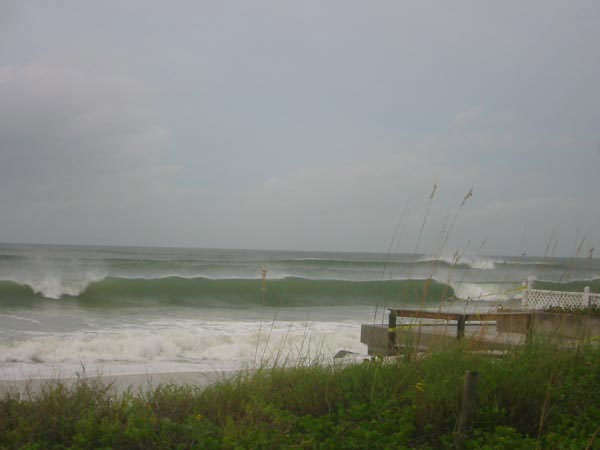
Near St. Pete Beach during Hurricane Ivan
If the reaction from local residents to surfers in their midst is surprise,
then the attitude of the international surf community can only be described
as astonishment. At least this used to be the case. When Cory and Shea
first made it onto the ASP World Tour, a new light began to shine on
the Gulf. "People were so amazed that we were able to do what we
do coming from where we're from," says Cory. "There's only
maybe two months of waves here a year, and those aren't really the highest
quality days." With the Lopez brothers both being top-ranked tour
contenders and the only siblings in surfing history to both win the
U.S. Open of Surfing, the world's largest competitive surfing event,
the industry has had to stand up and take notice that there's real potential
in guys coming off the Gulf.
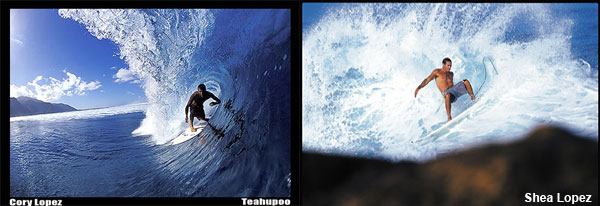
Cory and Shea's success has in no small part been due to their father,
Pete Lopez - himself an avid surfer and pioneer of the sport on the
Gulf. "It's a great place to learn to surf," says Cory. "Most
of the year the water's warm and you get a lot of small days. When you're
just a little kid, it's perfect to learn on and get the fundamentals
going." Both brothers started surfing at a very young age because
of their father's love for the sport. But neither of them would have
made it so far had it not been for their countless hours traveling.
Along with surf trips to the some of the best breaks in the world, almost
every weekend Pete would drive his sons three hours across the state
to surf the east coast.
Gulf coast surfers can't help but often envy their brothers on the other
side of the state. Part of the experience of being a surfer on the Gulf
is taking ritual journeys to the Atlantic. With a real ocean to send
solid swell, Florida's east coast generally sees waves that are bigger,
cleaner and more consistent than any average day back home. If a grom
from the Gulf has dreams to get good, he'll arrive at his coming of
age with a collection of memories from tired, red-eye, early-morning
road-trips with his friends, and even more tired, sandy, surfed-out
returns home. These are the experiences that identify a Gulf coast surfer
as part of his tribe.
The notion of a cohesive surf scene on the Gulf is one that even local
surfers themselves seem just now starting to recognize. In the past,
the surf community was characterized by a collection of disconnected
groups of surfers in different towns. There was a Clearwater crew, and
Indian Rocks Beach crew, a St. Pete crew, a Sarasota crew, a Venice
crew, but there was no scene.
"When I grew up we had no surf culture in the area whatsoever,"
says 36-year-old Greg Agerskov, veteran of gulf coast surfing and owner
of the Surf Shack in St. Pete Beach. "There was nothing to bring
everyone together." He says this is something he is trying to change.
When Greg and his wife, Robyn opened the Surf Shack in February 2004,
they wanted it to be more than just another surf shop. They wanted it
to be a place where kids could come and hang out. "I wanted to
do something for the groms and really make it a kid-friendly kind of
shop," Greg says.
The idea seems to have caught on as most of their weekends are filled
with local surf-stoked kids gathered on the back patio of the shop watching
videos and scarfing down Mama Robyn's cooking. Outside in the parking
lot, a skateboard ramp is an invitation for kids to stay occupied when
the Gulf is flat and practice their skills to take back into water when
the waves come. In the back room, still more local groms are surfing
the web for reports, forecasts, and pictures to see if the east coast
might be going off. If the Gulf happens to have some skim breaking on
the beach, the crew will drop in and out between skimboarding sessions.
The Surf Shack sponsors their own surf, skate and skim teams and gives
them 20 percent off all merchandise in the store.
Along with supporting the kids, the Surf Shack staff also works to get
local surfers involved in helping their community. They have spearheaded
two volunteer beach cleanups and are quickly planning a third. They
have rallied local businesses and national surf companies to donate
merchandise for fundraising raffles. They raised close to $1,000 to
support Red Cross relief efforts for victims of last year's hurricanes,
and they have also gathered funds to contribute to SurfAid International's
support of the tsunami victims. "It's just what we want to be about,"
says Surf Shack manager Barry Morse. "We're just trying to give
back to the community in a positive way."
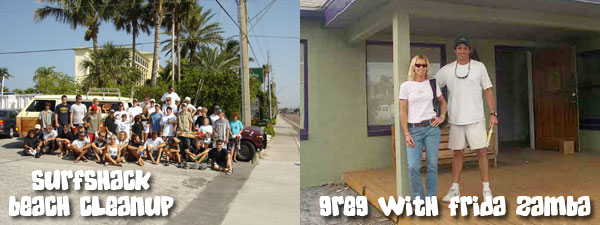
While Gulf coast surfers are ready to lend a helping hand, they're just
as eager when it comes time to party. In addition to hosting showings
of surf videos at the local theater, the Surf Shack has helped to sponsor
events like the video premiere party of The Puerto Rico Files, a project
by the local production company, Hatfield Enterprises. Characteristic
of the scene on the Gulf, Hatfield grew out of a group of friends just
surfing and having fun. Now they are throwing massive dodgeball parties
at local nightclubs, making full-length videos and sponsoring professional
riders like Timmy Reyes and Nick Guilarte. Hatfield video producer,
Dustin Howard says he's starting to see the Gulf coast surf culture
come into it's own. "It's kind of silent but it's getting woken
up right now," says Dustin. "And it's starting to become really
big." Dustin says he is enjoys surf videography because it provides
a way to document the development of his local surf culture. "We've
personified the surf community," says Dustin. "We've given
it a face."
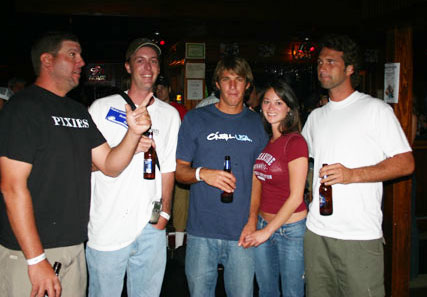
Cory Lopez and his girl friend hanging with Dustin Howard from
Hatfield,
Mike Young and Jah Surf at Boomerz nightclub in Seminole
When Cory Lopez is home, he spends a lot of time with Dustin and the
rest of the Hatfield family. One of their favorite places to chill is
Pajano's Pizza on Gulf Boulevard in Indian Rocks Beach, where fellow
surfer and friend Nick Faraone helps run the shop with his dad. Cory
has on occasion been known to bring other pros like Kelly Slater by
to say hello as well. When the Gulf is up, a day in the life of these
locals might consist of traveling south to Bradenton in the morning
to surf, coming back to Indian Rocks for lunch at Pajano's, an afternoon
session across the street at Twelfth Avenue, and then heading to Boomer'z
Boiler Room that night in Seminole to hear their friends' band, Crooked
Edge, play.
While the growth of the Gulf coast surf culture has been essentially
organic, there's no denying that a little high-tech help has contributed.
With the advent of the Internet, two major websites, Aura Surf and Gulfster.com,
have arisen to highlight surfing on the Gulf. These sites have provided
a sort of cyber-meeting-place for local surfers. "It helps to get
everybody excited and more stoked on surfing," Cory says. "They
get to see they're pictures in there and see what spots were good because
they're getting photos from different spots all over the Gulf."
Aura Surf founder Micah Weaver says the Internet made a genuine culture
more accessible to surfers on the Gulf. His site provides daily surf
reports and forecasts, as well as merchandise like cd's, videos, clothing
and even custom shaped surfboards available to buy. In addition, Aura
Surf posts extensive feature stories about expeditions to various international
surf spots and detailed articles about local surfing in St. Petersburg.
"I wanted people to know the Gulf coast had good waves and good
surfers," says Micah. "Plus, I always wanted to be a weatherman."
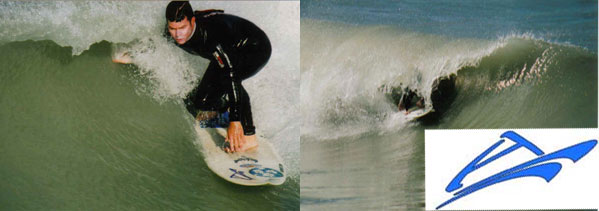
Micah Weaver
Aurasurf.com
Micah says one of the advantages of being a surfer on Florida's Gulf
coast is that while waves at home might not always be world-class, you're
located in a great spot for traveling to places where they are. Using
the term loosely he says, "If one ocean's not working you can always
go to the other ocean." Of course the Atlantic coast of Florida
is the Gulf coast surfer's bread and butter, but with two international
airports being less than an hour's drive away, surf vacations to Puerto
Rico, Jamaica, Costa Rica and other spots in the Caribbean and South
America can be an economic reality.
Pete and Matty Lopez at a Surfshack Beach cleanup
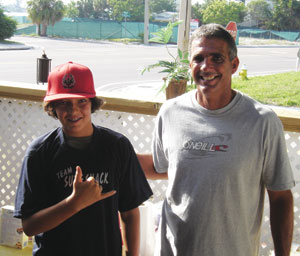
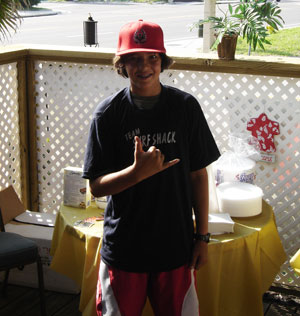
Matty launching the ramp outside of surfshack.
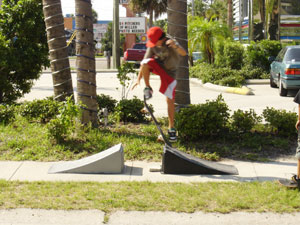
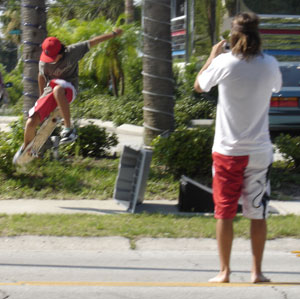
Many Gulf Coast surfers are following in the footsteps of the Lopez
brothers and proving competitively that the Gulf coast deserves to be
recognized. One of them is their younger brother Matty. In a family
that helped to shape the sport of surfing locally and around the world,
Matty is proving he certainly got the surfing standout gene as well.
Another local standout is Kyle Applefield, who is not only tearing up
the Eastern Surfing Association's West Florida District, but also winning
competitions on the East Coast. Skip Beach, ESA's West Florida Director
says there are a lot of kids coming up on the Gulf coast that are showing
a lot of talent. He says the level of support from parents is also greater
than he's ever seen before. " I've seen a real rise in the number
of parents showing up and staying on the beach in freezing cold weather
to watch their kids," says Skip. "That's pretty cool."

Kyle Applie Field And Taylor Brothers. 2 Up and coming groms
at the ESA comp 12/04
While everyone from the kids, to parents, to surf shops, to Skip and
others heading up the contests are excited about competitive surfing
on the Gulf, finding a place to hold contests has proven more difficult.
"Venice has just been fantastic," Skip says. "Where other
municipal entities for legal reasons have just been difficult at best."
According to Skip, in order for them to hold contests in West Florida
beach towns other than Venice, the cities want ESA to have insurance,
a paramedic on site, and a jet ski in the water at all times during
competitions. Unfortunately, such accommodations are simply unaffordable
for a small competitive surfing district on the Gulf. Thankfully, Venice
is not only accommodating to competitions, but it is also one of the
better breaking spots on the coast.
Along with many other technical criteria, ESA competitors are judged
on their level of sportsmanship. For most Gulf coast surfers, this seems
to come pretty naturally. "We're pretty laid back here," says
Cory. "There's always a couple of people out of every group that
are more aggressive but that's just like anything in life." In
spots like Hawaii, where the breaks are more crowded and the waves more
dangerous, Cory says surfers tend to get more "pumped up"
and localism is more prevalent. "Here we're dealing with small
waves and it's not like it's your life on the line if you fall when
someone messes you up," says Cory. "There's not quite as much
testosterone in the water here as there is there." This doesn't
mean people are likely to say thank you for dropping in on them, but
they are more apt to shrug you off as a kook than to start a fight.
As a successful professional surfer, Cory Lopez could live anywhere
he wanted in the world. So what brings him back to Indian Rocks Beach,
Florida? "This is just home," says Cory. " I've lived
on the same street my whole life in the same town. I love Indian Rocks
Beach. You might not get the adrenaline rush from surfing a 13 or 20-foot
wave, but you still have fun. I'm out with my friends and we're all
laughing at each other, yelling at each other and having a good time.
I think that's probably one of the biggest things is just being out
with friends, enjoying being in the water, and having a good time."
While surfers on Florida's Gulf coast certainly share a unique experience
and identity, it is ultimately the passion common to surfers around
the world that draws them from the shore into the water. Connecting
with the forces of nature and friendship breeds a hunger within them
to paddle out and find their place in the line-up. At the end of the
day, they are surfers and they will not be limited by their circumstances.